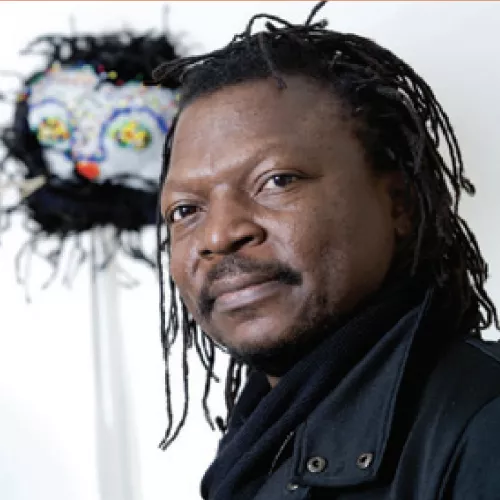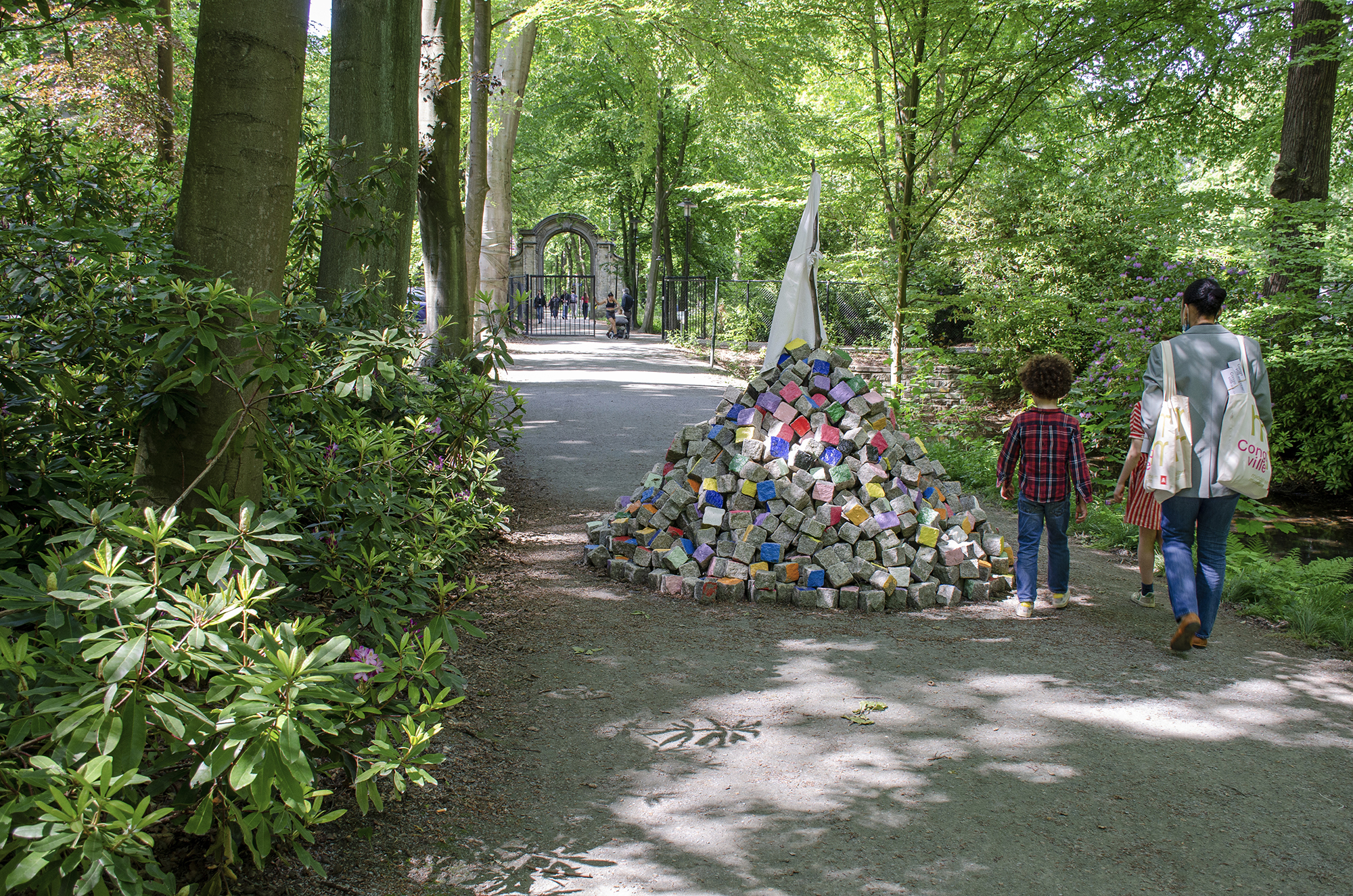
Colorful Invitation to Peace
Pascale Marthine Tayou in Congoville
"As a Black artist, I refer to 'people of color' with my colored cobblestones. My work invites peace. Let's not discuss the issues over each other's heads but engage in dialogue together." Wise words from artist Pascale Marthine Tayou in conversation with museum curator Pieter Boons.
Trendy Exotic Product
Pieter Boons: According to Sandrine Colard’s concept, Congoville represents the dense urban layer that results from the colonial history in Belgium: its buildings, monuments, imperial myths, and its Africandescendant population. What was the first thing that came to mind while reading the title of the show?
Pascale Marthine Tayou: Since the 1990s I have been evolving as a young artist in Belgium, and I got the impression that every year there has been a Congo celebration somewhere. It seems like there has been created a kind of trend or exotic product that we love to keep on consuming. It’s a seemingly typical Flemish intellectual desire to speak on the former colony, as a strange continuation of power.
A lot of cultural ‘products’ that come out are rather exclusive in terms of the knowledge or language required to participate in them. For instance: the series Kinderen van de Kolonisatie (Kids from the Colony) was broadcasted only in Flemish language, as if Congolese or French-speaking Belgians were not addressed. Therefore a lot of these projects reflect an atmosphere of ‘mea culpa’ without really engaging with all the people involved.
In a way I felt that Congoville is like a theater play performed on the same familiar stage. I really hope we can make something else from Congoville. Imagine that you want to remove a tree, therefore you also realize that shuffling the leaves will not do, you’ll have to dig to its roots.
Congo as a metaphor
To what extent is your work related to the concept of Congoville?
At first my work was totally not related to Congoville, and I wasn’t invited by the curator herself but directly by the museum’s curator and director during a studio visit in Ghent. Based on this discussion, we started eventually to collaborate, as I am always fascinated by the conversations I have with others and where they bring me.
However, I’m not interested in the intellectual system this exhibition proposes, which is to prove ‘a’ curatorial statement by performing my work as an artist. I am certainly not participating because I am an African-born artist or black.
I see ‘Congo’ as a metaphor: It’s a nation facing many problems, and its struggle is comparable to many other situations across the globe. My artistic practice is founded in my multi-ethnicity and in the specific conditions (and limitations) of this world today, so of course I have been directly and indirectly working with postcolonial issues in my work. Making these works is my personal way of dealing with societal problems and suggesting ways to look at them evoking possible solutions.
Imperial mindset
In her essay Sandrine Colard speaks about “unlearning an imperial mindset”. What can this mean to you?
This question brings a lot of other questions to the front: What is unlearning? Who has to unlearn what? Is it the imperialist? The human being? The colonizer or the colonized? If this question of ‘who’ relates itself to race, then why is the exhibition inviting black African or Afro-descendant artists that have to relate themselves to an overly white audience? Is the project’s ambition to show that a black knowledge exists and that it is an integral part of all existing knowledge?
Please let’s stop confronting one thing with its so-called opposite and think[ing] in extremes. We’ll need to be careful not to replace one form of imperialism by another new form of the same old thing. If you look to Africa, that’s exactly what is happening there right now, but I don’t believe that all the problems the continent is facing are caused by white people.
Black African leaders have become the imperialism’s accomplices or the new imperialists if you want. So starting a revolution, you should firstly know your enemy.
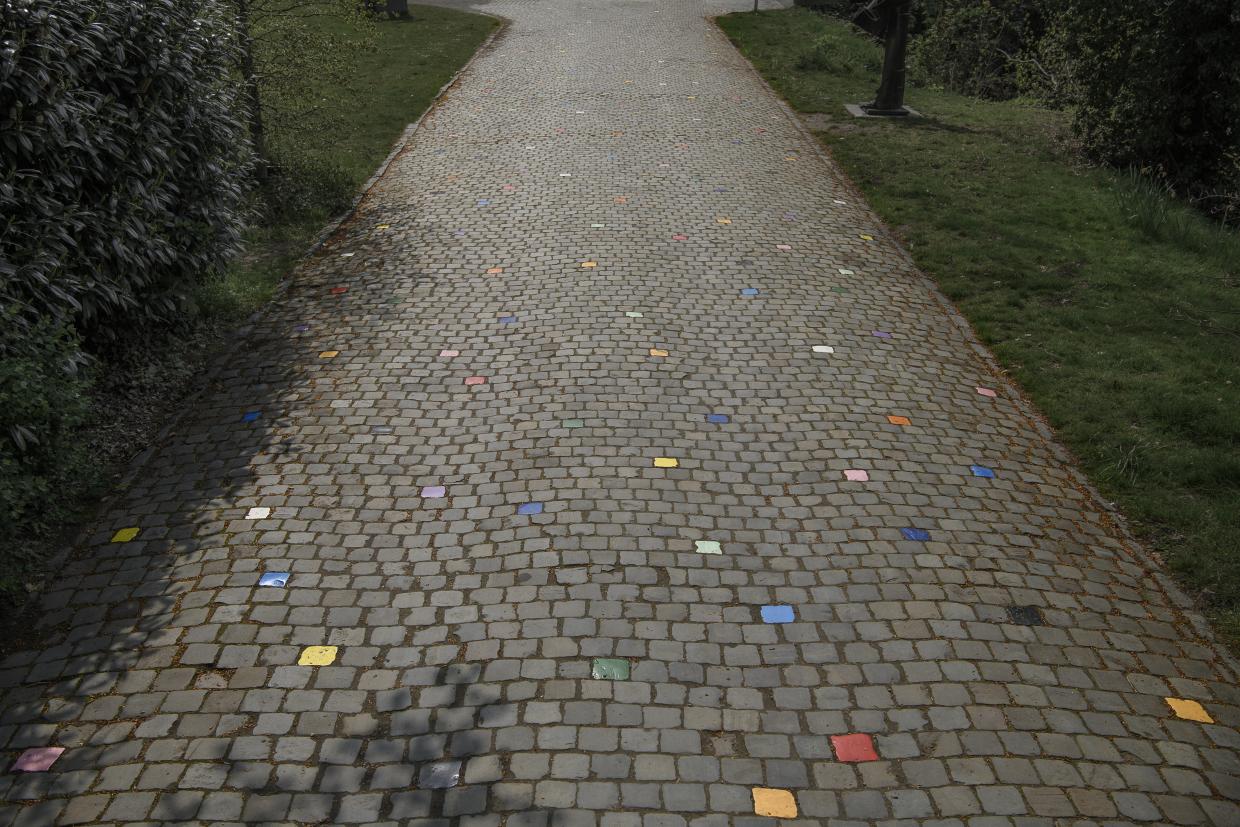
From one human being to another
According to me, the problem lies elsewhere and goes far beyond race in terms of color; it has to do with the human race as a whole. Here for I believe the question of imperialism should also address smaller conflicts between for instance the Flemish and Walloon people. Why addressing big questions like race, while this is ‘just’ one of the many big and small conflicts surrounding us?
If you really want to talk on a ‘deconstruction of imperialism’ (and I use the word deconstruction as to me this is more appropriate) there lacks the word ‘human’. I think we can counter imperialism by reducing it to the scale from one human being to another. So if we find ourselves in the museum amongst artists and especially amongst other people, this can be a place where we can meet, exchange, and learn; so the museum is an important place in these questions.
But we must take enough distance towards big statements involving imperialism, and foremost I think we have to stay calm and think or feel with our brains instead of solely with emotions. Before you can be a man, you have to be a child, and you have to be educated and learn.
Touch fire
Congoville unfolds the untold colonial history of the ‘Middelheim’ in a vast exhibition that will run for almost five months. What could be the longterm preferred impact of this project or how can we consolidate the knowledge that will appear?
I found it interesting to hear from you in our discussions that there is a colonial story linked to the site of Middelheim. This surely needs to be told; it’s a form of education as I think the people of Antwerp are totally unaware. So participating in this project can be a way of going to the origin of things.
Watch out we don’t scare people, but let’s allow them to touch fire, and then we’ll treat them after. (laughs)
Congoville can be a way of education, but please let’s see the works as a laboratory on many levels and not only as an intellectual or aesthetic experience. Engaging with just one way of looking could be read as a new form of imperialism. So, according to me the institution has the responsibility to go beyond the works and the system of this project and go to the basis of these topics, to touch common ground and implement this as a relation between everyday people. We will see; I’m curious to evolve in this project.
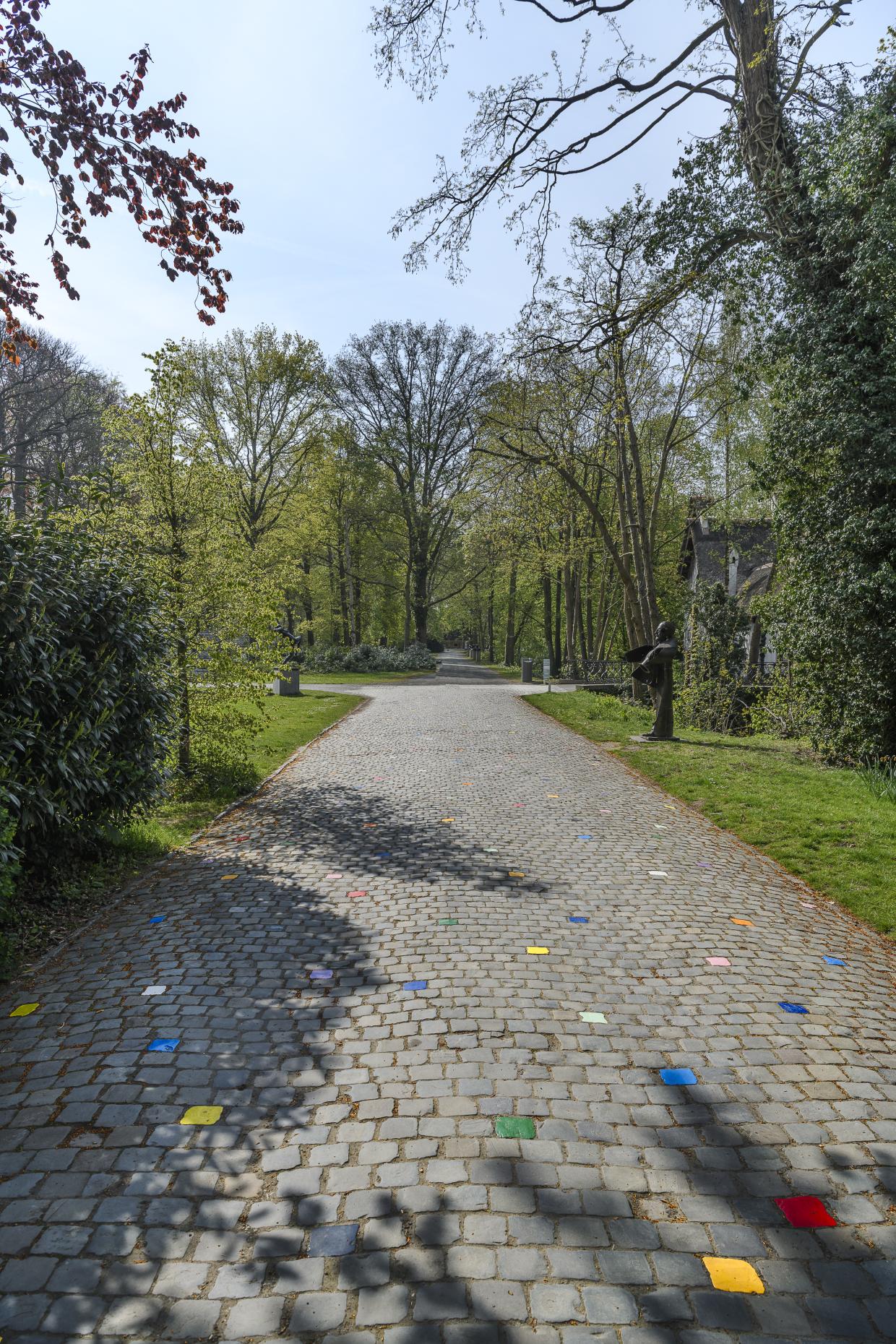

Bricks and colors
Let’s talk about your work in the Congoville exhibition. What are the ideas behind the works you show here?
The two works included in Congoville are visually familiar, as they both include bricks and colors. Le Chemin du Bonheur talks about happiness, as I found myself being confronted on a daily basis with all kinds of crisis. When I first realized this work in 2012 on the grounds of the Castello di Ama (Italy), I was challenged of contributing with a work in a space that was actually already occupied by other artists. Looking for a balance between all the ‘inhabitants’ of this place, I came up with the idea of intervening on an existing road leading from the main entrance to the vineyards, that one could regard as a ‘paradise’; the land is providing the owner’s income and pleasure. That’s also what the title expresses. Le Chemin du Bonheur is, like other works I’ve made, a way (literally) of bringing some light in the darkness.
La Paix des Braves, the other work presented in Congoville, expresses more or less the same idea. Their titles share a linguistic similarity and speak directly about the work’s meanings. La Paix des Braves for instance states that all people are right, they all matter, so we can cease fire and end the revolution. Every color represents a different person, a different story, a different pain.
Invitation to make peace
As a black artist I refer to ‘the people of color’ by using these colored bricks. The work invites to make peace, not just as a festive moment but as a fire that starts burning out from your own soul. This standstill or surrender, represented by the white flag, is the only moment in combat I really like. All the rest is bollocks and unnecessary.
So my proposal is not for problems and discourses to be summed up or negotiated above each other but for us to finally settle down and to go into a dialogue with each other. The peace (or happiness) I speak about needs to be universal, starting from myself but spreading all over the globe. So these two works talk about revolution as a change not by starting it, but by ending it.
How do you engage with art as a possible strategy for healing?
A curator is like a doctor, the word itself implies a certain ‘cure’. But the healing is not to be found in words alone, therefore we need other engagements as well. Using only words to heal, or to cause change, will not work. Again, let’s be humble and realize from which position we can move forwards.
The reason why we are still discussing the postcolonial condition is because the problems haven’t been solved yet. So if you want to address problems, I believe you need to come along with solutions and not with sticks or accusations.
To heal we need a method, I guess embracing colonial history as a shared history that belongs to all of us could be a first step. And this attitude could be a step on the way to the happiness of future generations, a possible chemin de bonheur.
Which book do you suggest to read within the context of your work in this exhibition?
Thomas Bärnthaler, Do It Yourself: 50 Projects by Designers and Artists (London: Phaidon Press, 2015)
Curator Pieter Boons in conversation with Pascale Marthine Tayou.
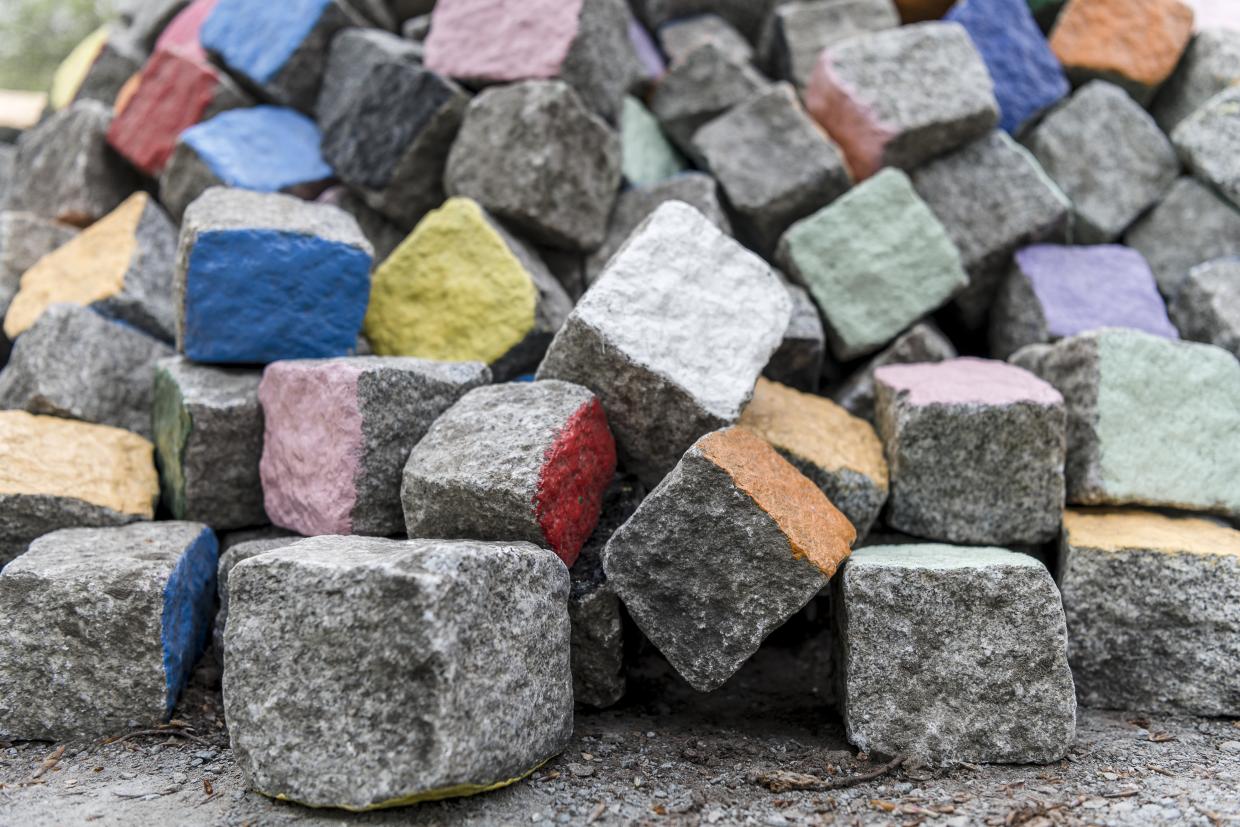
About Pascale Marthine Tayou
Pascale Marthine Tayou was born in Cameroon in 1966 and lives and works in Ghent, Belgium, and Yaounde, Cameroon. At the beginning of his career, the artist feminized his first and middle name into “Pascale Marthine” with the intention of undermining the importance given to authorship and gender in the art world.
Tayou works with a multiplicity of media and topics. Whether in the form of sculptures, installations, videos, drawings, or objects, his practice centers around the hybridization of cultures, the individual journey in the globalized world, and the place and perception of his African identity in it.
Tayou’s work has been presented in solo and group shows all around the world, including at:
- Mu.ZEE (2019)
- Bozar (2015)
- Kassel documenta 11 (2002)
- Venice Biennale (2005, 2009)
- Turin (2008)
- London Tate Modern (2009)
- Gwangju Biennale (1997, 1999)
- Santa Fe (1997)
- Sydney (1997)
- Havana (1997, 2006)
